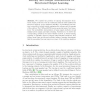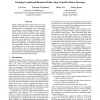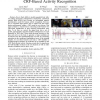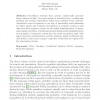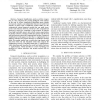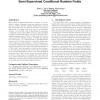PKDD
2010
Springer
14 years 2 months ago
2010
Springer
Abstract. We consider the problem of training discriminative structured output predictors, such as conditional random fields (CRFs) and structured support vector machines (SSVMs)....
IJRR
2007
14 years 4 months ago
2007
Learning patterns of human behavior from sensor data is extremely important for high-level activity inference. We show how to extract a person’s activities and significant plac...
IJCAI
2007
14 years 5 months ago
2007
While conditional random fields (CRFs) have been applied successfully in a variety of domains, their training remains a challenging task. In this paper, we introduce a novel trai...
SIGIR
2003
ACM
14 years 9 months ago
2003
ACM
The ability to find tables and extract information from them is a necessary component of data mining, question answering, and other information retrieval tasks. Documents often c...
ICPR
2010
IEEE
14 years 9 months ago
2010
IEEE
Abstract—Due to their ability to model sequential data without making unnecessary independence assumptions, conditional random fields (CRFs) have become an increasingly popular ...
ISVC
2007
Springer
14 years 10 months ago
2007
Springer
Surveillance systems that operate continuously generate large volumes of data. One such system is described here, continuously tracking and storing observations taken from multiple...
IROS
2007
IEEE
14 years 10 months ago
2007
IEEE
Abstract— Temporal classification, such as activity recognition, is a key component for creating intelligent robot systems. In the case of robots, classification algorithms mus...
ICMCS
2007
IEEE
14 years 10 months ago
2007
IEEE
Automatic segmentation and classification of recorded meetings provides a basis towards understanding the content of a meeting. It enables effective browsing and querying in a me...
ICRA
2008
IEEE
14 years 10 months ago
2008
IEEE
— We investigate modeling and recognition of object manipulation actions for the purpose of imitation based learning in robotics. To model the process, we are using a combination...
SIGIR
2009
ACM
14 years 10 months ago
2009
ACM
When search is against structured documents, it is beneficial to extract information from user queries in a format that is consistent with the backend data structure. As one step...
